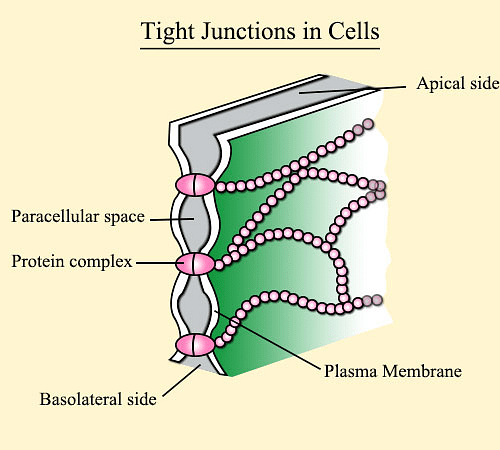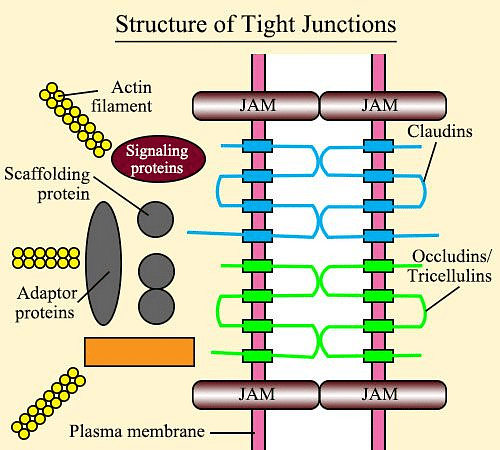
Content Strategy Manager
Tight junctions are one of the three intercellular junctions that seal the empty space between the cells of an epithelium, forming a barrier between the two adjacent cells. This enables the separation of tissue compartments. These junctions help to prevent molecules from passing between cells and also help in maintaining the polarity and osmotic balance of the cells. This barrier is essential to enable the vectorial transport of materials from one region to the other and prevent the entry of harmful toxins and microbes. They are only found in vertebrates. Apart from all this, tight junctions also serve as a way to hold the cells together and prevent them from ripping apart.
| Table of Content |
Key Terms: Tight Junctions, Intercellular Junctions, Epithelium, Cells, Tissues, Vertebrates, Polarity, Osmotic Balance
Structure of Tight Junctions
[Click Here for Sample Questions]
Tight Junctions are composed of a branching chain of sealing strands that are linked with each other throughout the surface membrane of the cell. These strands are independent of each other resulting in an increase in efficiency of the junction in preventing ion passages exponentially.

Tight Junctions
TJs are formed by at least 40 different types of proteins. These proteins can be grouped into 4 main types. The actual barrier between the cells is formed by stable sealing strands of transmembrane proteins. Transmembrane proteins are located in the middle of the cell membrane and are responsible for adhesion and permeability. Then comes the scaffolding proteins which organize the transmembrane proteins. The next ones are the Signalling proteins which are responsible for forming the tight junction and regulating the barrier.
Read More: Difference Between Adhesion and Cohesion
The last one is the regulating proteins that regulate what proteins are to be brought into the cell membrane through vesicles. These proteins include occludin, claudin, and JAMs (Junction adhesion molecules). The transmembrane proteins are attached to a chain of multi-PDZ proteins like ZO -1,-2, and -3; they are also known as peripheral membrane proteins.
Occludin
- They have a total molecular weight of 60kDa
- They have four transmembrane domains.
- They form two extracellular loops and one intracellular loop. These loops help in the regulation of paracellular permeability.
- They play one of the most important roles in cellular structure and barrier function.
- They were also the first integral protein to be identified.
Claudins
- They have a total molecular weight of 20kDa.
- They also have four transmembrane domains and a similar loop structure.
- They are the backbone of Tight junctions and play a significant role in the TJs’ ability to seal the paracellular space.
- They were identified right after Occludins.
Read More: Epithelial, Connective, Muscle and Nervous Tissues
Junctional Adhesion Molecules (JAMs)
- They have a total molecular weight of 40 kDa.
- They differ from other transmembrane proteins in structure. They only have one transmembrane domain.
- They help in the regulation of paracellular pathway function of tight junctions and are involved in helping of maintaining cell polarity.

Structure of Tight Junctions
Read More: Difference Between Vertebrates and Invertebrates
Functions of Tight Junctions
[Click Here for Sample Questions]
The major functions of tight junctions are as follows:
- Tight junctions grant endothelial and epithelial cells with a barrier function. This barrier can be further sub-divided into protective barriers and functional barriers, whose serving purposes are to transport material and to maintain the osmotic balance.
- One of their main functions is the prevention of the passing of unwanted particles from adjacent cells. They prevent molecules and ions from passing between the plasma membranes of adjacent cells, making the passage of materials to the tissue only possible through diffusion or active transport.
- TJs also function to maintain the polarity of the cells by prohibiting lateral diffusion of integral membrane proteins between the lateral or basal surfaces. This allows the specialized functions of each surface to be preserved and grants polarized transcellular transport and specialised functions of apical and basolateral membranes to exist.
- The simplest of functions that the tight junction does is to hold the cells together. The protein strands of tight junctions link the adjacent cells together super tight allowing them to form the shape of a sheet. These protein strands are fastened to the microfilaments. Microfilaments are made up of actin proteins and are located inside the cell. The combination of microfilaments and sealing strands binds the cells together from both inside and outside.
Read More: Electrical and Chemical Synapse, Synaptic Polarization
Tight Junctions: Association with Diseases
[Click Here for Sample Questions]
When the Tight junction barrier fails, materials can cross the epithelia in an unregulated manner. This will lead to the breach of the barrier by antigens and microbes. Anything that alters the cell metabolism will negatively impact the barrier, making Tight Junctions a constant contributor to a vast range of pathologies. It is difficult to stir up specific Tight junction components.
Read More: Types & Osmoregulation in Different Organisms
Things to Remember
- Tight junctions are intercellular junctions that seal the empty space between the cells of an epithelium, forming a barrier between the two cells.
- The barrier between the cells is formed by stable sealing strands of transmembrane proteins, such as claudins and occludins.
- The Tight junctions prevent the passing of unwanted particles from adjacent cells. They prevent molecules and ions from passing between the plasma membranes of the adjacent cells, allowing the passage of materials to the tissue only possible through other methods like diffusion or active transport which the cell has total control of.
- TJs also function to maintain the polarity and osmotic balance of the cells.
- The simplest of functions that the tight junction does is to hold the cells together.
Sample Questions
Ques. What are tight junctions? (3 Marks)
Ans. It is an intercellular junction between epithelial cells to which the outer layers of the cell membranes fuse, holding adjacent cells together and reducing the ability of larger molecules and water to pass between the cells.
Ques. What is the purpose of transmembrane proteins in a tight junction? (3 Marks)
Ans. The barrier between the cells is formed by stable sealing strands of transmembrane proteins. Transmembrane proteins are located in the middle of the cell membrane and are responsible for adhesion and permeability.
Ques. What do you mean by occludin tight junctions? (3 Marks)
Ans. Occludin tight junctions have a total molecular mass of 60kDa and they have four transmembrane domains. They form two extracellular loops and one intracellular loop which help in the regulation of paracellular permeability. They play one of the most important roles in cellular structure and barrier function. They were also the first integral protein to be identified.
Ques. What are Claudins? (3 Marks)
Ans. Claudins are the backbone of Tight junctions and play a significant role in their ability to seal the paracellular space. They have a total molecular mass of 20kDa and they have four transmembrane domains and a similar loop structure. They were identified right after Occludins.
Ques. Name a few proteins that make up the Tight junction. (3 Marks)
Ans. Tight junctions are made up of transmembrane proteins such as claudins and occludins, cytoplasmic scaffolding proteins like ZO-1, -2, and -3 and Junctional Adhesion Molecules(JAMs).
Ques. What are the four main types of proteins found in a Tight Junction? (5 Marks)
Ans. The proteins can be grouped into four main types.
- The barrier between the cells is formed by stable sealing strands of Transmembrane proteins. Transmembrane proteins are located in the middle of the cell membrane and are responsible for adhesion and permeability.
- Then comes the Scaffolding proteins which help to organise the transmembrane proteins.
- The next ones are the Signalling proteins which are responsible for forming the tight junction and regulating the barrier.
- The last one is the regulating proteins that regulate what proteins are to be brought into the cell membrane through vesicles.
Ques. What type of organisms possesses tight junctions between the cells of the epithelium? (1 Mark)
Ans. Tight Junctions are only found in vertebrates, i.e; animals with a backbone and a skeleton.
Ques. Explain the functions of tight junctions in detail. (5 Marks)
Ans. The functions of tight junctions are:
- Tight junctions hold the cells together. The protein strands of tight junctions link the adjacent cells together super tight allowing them to form the shape of a sheet.
- Tight junctions provide endothelial and epithelial cells with a barrier function to transport material and maintain the osmotic balance.
- They prevent the passing of unwanted particles from adjacent cells. They prevent molecules and ions from passing between the plasma membranes of adjacent cells, making the passage of materials to the tissue only possible through diffusion or active transport.
- They maintain the polarity of the cells by prohibiting lateral diffusion of integral membrane proteins between the lateral or basal surfaces.
Check-Out:





Comments